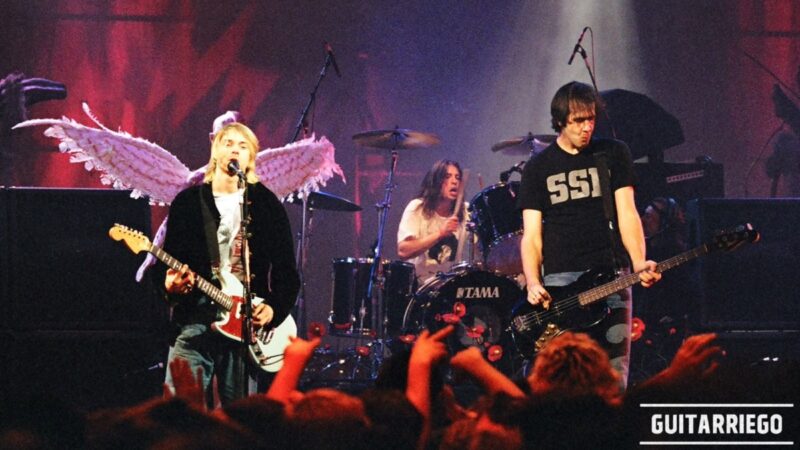How to read sheet music: learn to read music for guitar and bass
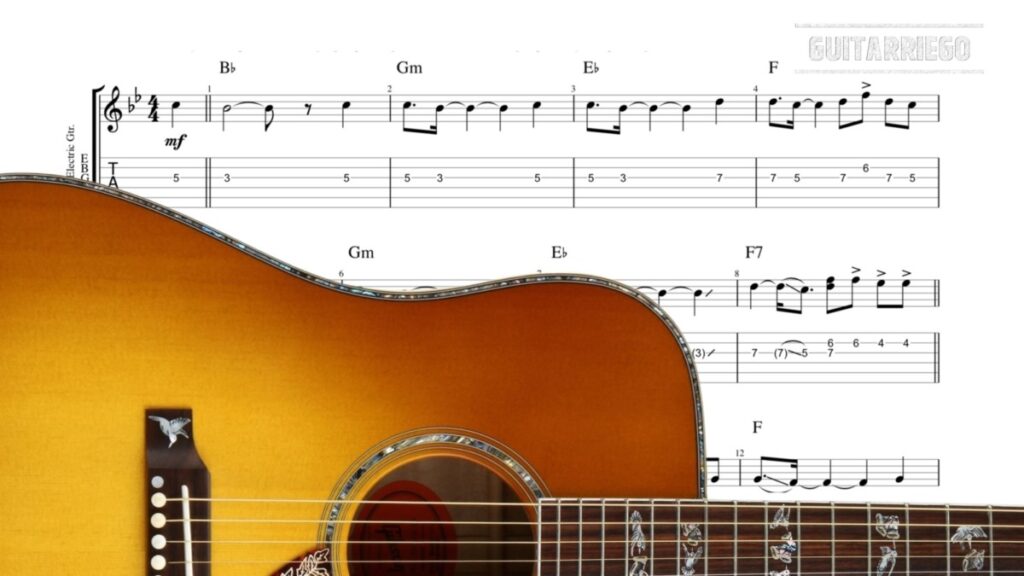
Learning to read music is essential in your growth as a musician, we teach you how to read sheet music for guitar and bass.
Learn to read sheet music quickly and easily
Reading a sheet music or a score is a skill that adds a lot of value to any musician. Even if you are self-taught, knowing how to interpret written music and, therefore, being able to write it, will give you access to communicate with other musicians in a precise way.
In a score, music transcends time and space, since it can house all the tools to capture almost any aspect of musical discourse.
In this post we are going to talk about how to read sheet music or a score quickly and easily, how to read music at first sight, how to interpret key signatures, clefs, figures and other general aspects of this topic.
What is Tonic, Sol-Fa or Solfeggio and how to learn for guitar and bass?
Tonic, Sol-Fa or Solfeggio is the discipline of reading and writing music, that is, it is the technique for writing and reading scores. Here we will teach you the basic musical concepts so that you can learn music theory for electric or acoustic guitar and bass Tonic, Sol-Fa or Solfeggio.
You may also be interested in our lesson on the 7 musical modes and their relationship to chords.
What is a sheet music?
The sheet music or musical score is a writing in which, with special symbols, it is represented how a musical piece is interpreted.
These symbols relate to expression, performance, and other aspects of music, as well as a comprehensive system of notation. All this allows adjusting to the original idea of the author of a musical piece.
Elements of a sheet music or musical
Sheet music works for any musical instrument, but here we are going to focus on guitar and bass. To translate the music into a score, a type of paper called musical lined paper -or just music paper- is used, which has five line sets called staffs -in US- or staves -in UK-.
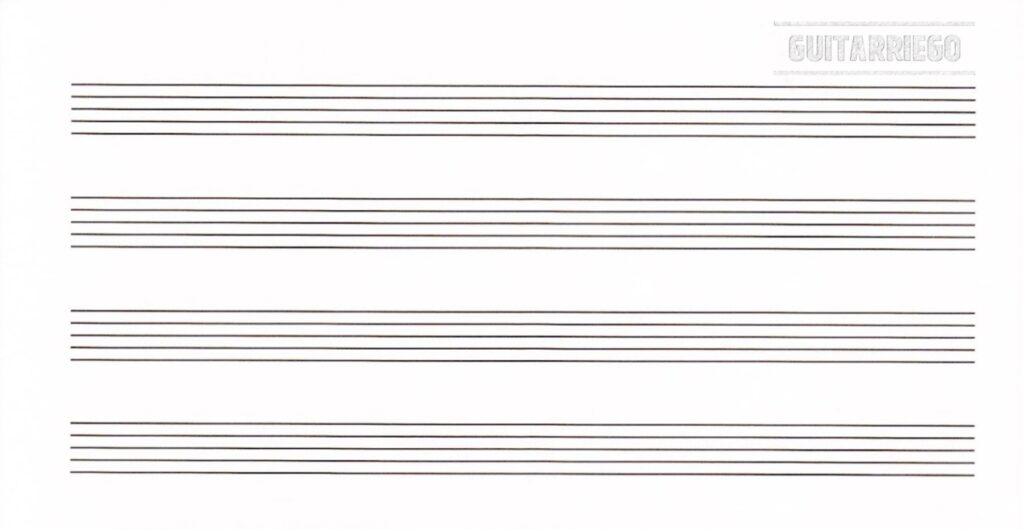
The musical staff (or stave)
A staff -in US or stave in UK- is a set of five parallel lines, plus four interior spaces between them. On these lines and spaces musical notes and other symbols are placed.
Additional lines and their corresponding spaces can also be included, both below and above the staff -or stave-, to accommodate other lower or higher notes respectively.
Music written for most instruments is written on a single staff, since it is large enough to contain all possible notes. However, other instruments, such as the piano or the organ, require two staffs, one for each hand, joined by different clefs. This is because they have a broader tessitura, more sounds from the lowest to the highest.
Also, multiple staffs or staves can be joined together with a brace on their left side to write music that is played by multiple instruments at the same time, such as a string quartet or trio, woodwind, brass, and so on.
Don’t miss our tutorial on the Blues scale with the pentatonic scale, the Blue Note and the major third.
Musical clef
The first element that we find in the staff is a figure called clef. The clef is used to define the positions of the sounds or notes, according to their height, in each of the lines and spaces of the staff.
Most used musical clefs are four:
- Treble clef
- Bass clef
- Tenor clef
- Alto clef
For the guitar only the treble clef or G-clef is used, while for the bass the Bass clef or F-clef is used. In turn, the piano uses the Treble clef for the right hand and the Bass clef for the left hand. The rest of the clefs have other uses, such as transporting to another key.

The treble clef -on the left in the image- indicates that the G note is on the second line. Therefore, in the next space up is the next note in the musical scale, that is, A. In turn, the Bass clef indicates that the F note is on the fourth line. The following one, the Alto Clef, indicates where is the C note, in que third one, the C note is in the third line. While in the Tenor Clef the C is in the fourth line.
Visit our selection of the best easy songs to play on guitar for beginners.
The positions of musical notes on the staff
Therefore, the notes of the lines in the treble clef are:
- E
- G
- B
- D
- F
And those of the spaces:
- F
- A
- C
- E
If there was a need to write a note lower than the E of the first line, the spaces and additional lines below that we talked about earlier would be used. For example, the first additional line below the staff corresponds to the note C. Turn the first space just below the first line, to the D note, and so on. Below you can see a staff with the additional line of C in the treble clef for guitar. Also, below you can see the equivalent in the bass clef for bass.
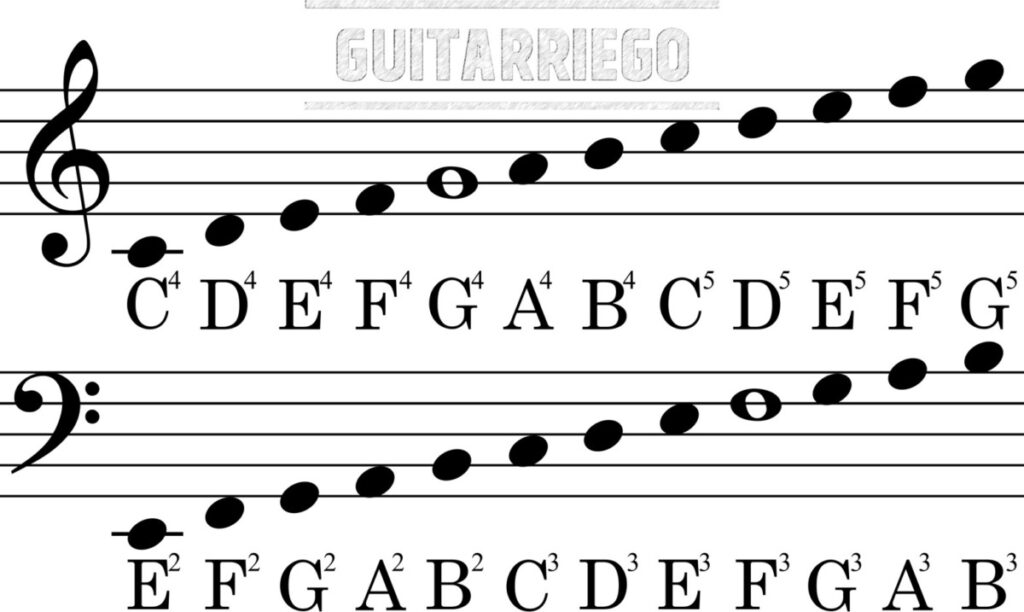
At the top of the staff it happens the same way: The first space above the staff with the treble clef is G, the first additional line, an A, and so on.
The location of the guitar notes on the Staff
The E of the first line of the staff with the treble clef corresponds to the E of the second fret of the fourth string of the guitar. Thus, the E of the open sixth string in the staff or stave is located in the fourth additional space below. This note would be the lowest note on a guitar in standard tuning.
Consequently, the E of the last space -between the fourth and fifth lines- is the E of the first open string. From there it continues with additional lines and spaces that correspond to the next notes you can play on the first string of the guitar.
It is important that when learning to read music on sheet music, you already know the location of musical notes on the guitar fretboard.
Key signature
Just after the clef appears a set of symbols that indicate the alterations of the tonality of the musical piece. It can be a group of sharps (#) or flats (b), each on a line or space on the staff.
This group of sharps or flats is the key signature and tells us in which key the musical work is written.
The tonality of C Major has no alterations, neither sharp nor flat, since its notes are: C, D, E, F, G, A, B. Therefore, if we find a music sheet that has nothing in place of the key signature, it means that the work, or song is in the key of C Major or its relative minor key, A minor.
In the scores that have alterations in the key signature, we must know what key it is according to the set of sharps or flats, either by what they are or, simply, how many. For example, if only one accidental appears in the key signature, which is F#, it means that the key is G Major or E minor. If three appear, F#, C# and G#, the key is A Major. Or if the accidentals are four flats, for example Bb, Eb, Ab and Reb, the key of the song will be A flat Major or F minor.
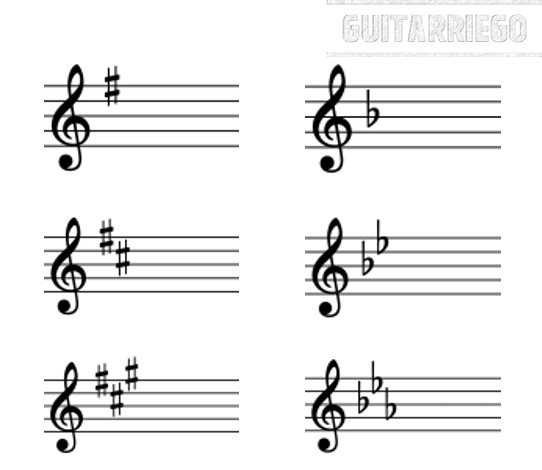
Table with each key signature and its corresponding major and minor key
How do we know which ones and how many alterations each tonality has?
A practical way to know the alterations of each tonality is with the circle of fifths. This has the series of all the tones arranged in such a way that it is easy to handle and memorize.
Musical figures
Musical figures are the symbols that represent the notes graphically. The position on the staff or stave defines the note, and each type of figure defines the duration of the note. Thus, they express duration and, depending on their arrangement in the guidelines or on the staff, they also indicate the height of the sound.
The main musical figures are seven:
- Whole note
- Half note
- Quarter note
- Eighth note
- Sixteenth note
- Thirty-second note
- Sixty-fourth note

Rhythmic values of musical figures
The highest value figure is the whole that lasts 4 beats, which is equivalent to a full 4/4 measure. Thus, the starting point will be the Whole note, so each figure is worth half of its previous figure. Thus, the Half note one lasts half the whole note, then the quarter note half the half note, and so on, as can be seen in the table below:

For simplicity, the picture reaches the sixteenth note, but the same thing happens with the thirty-second note which lasts half the sixteenth note, and the Sixty-fourth note, which lasts half the thirty-second note. Conversely, the whole note lasts twice as much as a half note, and the half note lasts twice as much as a quarter note, and so on.
Taking what was explained above to numbers, the values are as follows:
| Figure | Beats |
|---|---|
| Whole note | 4 |
| Half note | 2 |
| Quarter note | 1 |
| Eighth note | 1/2 |
| Sixteenth note | 1/4 |
| Thirty-second note | 1/8 |
| Sixty-fourth note | 1/16 |

You may be interested in our review of the best Smartphone and iPhone apps to learn guitar for beginners.
Dotted Note
If after the musical figure -to the right- a dot is placed, the duration of any of the previous figures is increased by half. Thus the notted note last a 1,5 of the figure. That is, if a dot is added to a quarter note that lasts 2 beats, it means that that note lasts 1 more beat -half the value of the quarter note-, totaling 3 beats. In the case of a dotted whole note, it will last 6 beats since it adds half of its value, which is 2, to the whole note that last 4 beats.

In turn, several dots can be combined, which will add half the value of the previous dot. For example, if we add two dots after a whole note, the first dot adds 2 beats -half the value of the whole note, which is 4-, and the second dot will add 1 beat, which is half the value of the previous dot. You can see it in the image below:
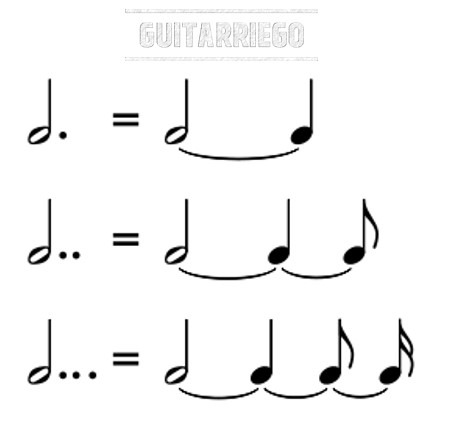
| without dot | a dot | two dots | three dots | four dots | |
|---|---|---|---|---|---|
| Duration | 0 | 1⁄2 = 0.5 _ | 1⁄4 = 0.25 _ | 1 ⁄ 8 = 0.125 | 1⁄16 = 0.0625 _ |
| Decimal result | one | 1.5 | 1.75 | 1,875 | 1.9375 |
| fractional result | one | 1 1 ⁄ 2 | 1 3 ⁄ 4 | 1 7 ⁄ 8 | 1 15 ⁄ 16 |
Groups of special valuation: Truplet, Pentuplet, Sextuplet, Septuplet
Here we find truplets, which consist of three notes where there would normally be two. In addition, if a figure is grouped together with another of half its value where only the first would fit, it is also a truplet. The truplet is encrypted with an arc that covers the figures involved and within which there is a 3.

Also, within the groups of special valuation we will find the pentuplets -of 5 notes-, the sextuplets -of 6 notes-, the septuplets -of 7 notes- and other less used. These are encrypted in a similar way to the truplet, but instead of 3, 5, 6 and 7 are used for the truplet, pentuplet, sextuplet and septuplet respectively, there is the different number that indicates how many sounds are played in a beat.
Silences musical figures and their values
In turn, each figure corresponds to a silence, which has the same duration as the note to which the figure corresponds:

Other musical figures
As well as the most common musical figures: whole, half note, quarter note, eighth note, sixteenth note, thirty-second note, and sixty-fourth note; there are others less used, such as the Double whole note that is equivalent to two Whole Notes and is practically in disuse; or the Hundred twenty-eighth note and the two hundred fifty-sixth note that are equivalent to 1/128 and 1/256 respectively of the value of a Whole Note. These are used exceptionally for works of extreme virtuosity.
You might be interested in our guide on how to write a song: lyrics, music, title and ideas.
Dynamics markings and changes
Dynamics or volume changes are used to regulate the loudness of entire notes or phrases. They are represented with angles that, depending on whether they are open to the right or to the left, gradually increase or decrease the intensity of the sound. Thus, it can also be expressed in words: crescendo < which implies that the intensity increases and diminuendo > which implies that the intensity decreases.
Also below we can see the table of dynamics markings -nuances-, to know with what intensity and dynamics to play the piece of music.
| Dynamic | In Italian | Intensity |
|---|---|---|
| ff | fortissimo | Very strong |
| f | forte | Strong |
| mf | mezzo forte | Medium-Strong |
| mp | mezzo-piano | Medium-Slow |
| p | piano | Slow |
| pp | pianissimo | Very slow |
Grace notes and articulations
Articulations and grace notes are ways of enriching the melody, with effects or ornaments that give flourishes to the piece of music.
Musical articulations
- Legato
- Pizzicato
- Staccato
Legato
Legato means that the phrase has a sound continuity, without interruptions or intermediate silences, even without modifying the intensity. Thus, Legato means that you must play the notes smoothly, without leaving any space between one note and the next. It is represented by an arc that spans the tied notes.

Pizzicato
Pizzicato is a technique widely used on guitar, especially on electric guitar. This technique comes from the violin and is done by pinching the strings instead of playing them with the bow.
On guitar the Pizzicato is performed by Palm Muting technique. The technique consists of supporting the left part of the right hand just above the bridge and thus partially muting the strings, so that the sound is immediately cut off. The Pizzocato is written with a circle with a vertical line above the note with the same word Pizzicato. You also can find PM or P.M. that stands for Palm Muting.

Staccato
Staccatto is used in musical notation, generally by means of a dot or a small “v” above the note, to indicate that a certain note should be sounded shortened, so that it is clearly separated from the next one, and with greater intensity. In addition, it also implies a slight accent.

Grace notes
- Arpeggio
- Glissando (Slide)
- Bending
- Vibrato
- Mordent
Arpeggio
The arpeggio consists of playing the notes of a chord separately, more or less quickly.

Glissando or Slide
It is widely used on the guitar and consists of moving from one note to another with the same touch by dragging or sliding your finger from one position to another.

Bending
Bendings, as you should already know, are stretching of strings, taking them to a higher pitch, which can range from a 1/4 tone or less, a semitone, a tone or more. They are represented by a curved line that marks the tone you must stretch. In the following example, a single tone bending is indicated.
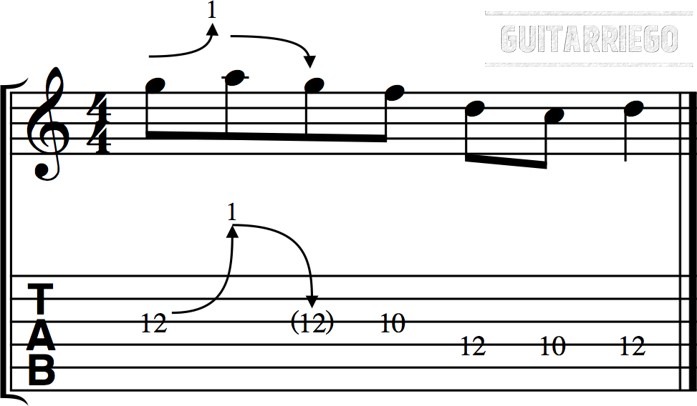
We recommend that you visit this tutorial on the CAGED system on guitar to play chords and arpeggios on the entire fretboard.
Mordent
The mordent is performed by quickly playing the note higher or lower than the actual note before it. It is a small delay of the melodic note. There are several types of mordent:
- Upper and lower mordents
- Single and double mordents
- Mordents with prefixed note
- Grade and jump mordents
- Lead and lag mordents

Time signature
Just after the clef and the key signature, another important element is written, since it is the one that defines the type of compass in which the musical work is. This element is the time signature.
Time signature consists of a broken number in which you have to interpret the numerator and the denominator to know how many and which musical figures fit in it. The numerator indicates how many notes are going to go into the whole measure, one in each part. The denominator refers to what type of figure these notes are.
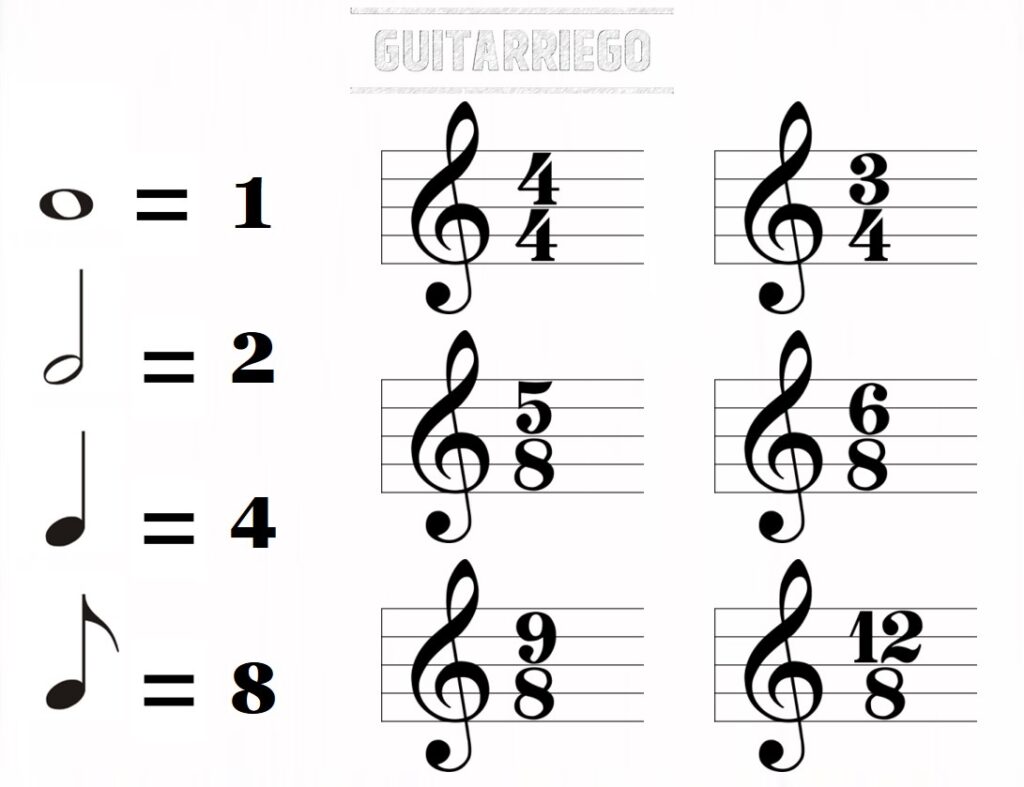
In the picture above there are six examples of time signatures; each is a different fractional number. The first from the left is 4/4: the 4 in the numerator means that the measure has four parts. And each of these parts corresponds to a Quarter note, as we can see in the image on the right. Since 4/4 time is the most common, for simplicity it is also sometimes expressed with the C sign. Also, if the C is crossed with a vertical line 𝄵 it means 2/2 time signature.
Another example: the one on the top right, which says ¾, means that the compass has three parts and that a quarter note fits in each of them. In the 5/8: five parts and a eighth note in each one. The other examples in the chart are: 6/8, which means six eighth notes since the 8 represents the eighth note; 9/8 which means that nine notes enter. And the last example, which is 12/8 and represents a measure of twelve parts in each of which there is a eighth note.
Always practice with metronome
We recommend that you practice with our free online metronome to practice beats on your guitar.
The measure or bar
The measure or bar is a metering structure used to organize music. They are represented with “boxes” between two barlines, inside which the figures or silences, alterations and other musical symbols are placed.
The measure can be binary, ternary or quaternary, depending on their division into beats or parts. There are also irregular bars or measures.
A binary measure is divided into two parts. Each of these parts can be subdivided in turn in a binary or ternary way. Ternary subdivision measure are also known as compound measure. Examples of binary division measure are 2/4 or 6/8. The measure of 2/4 is of binary subdivision and 6/8, ternary.
Triple division measures can also be simple or compound. A measure of simple ternary division, that is, of binary subdivision, is ¾. Time signature of ternary division and ternary subdivision is also 9/8.
A quaternary division measure can also be subdivided binary or ternary. The first case would be 4/4 and the second, 12/8.

The measures or bars are formed by the vertical dividing lines on the staff, also called barlines. These bar lines can appear single, double, or with reapet symbol to indicate repetitions of fragments, changes of key or beat.
You might be interested in taking a look at our lesson on learning guitar scales for beginners.
Single Bar Line
It is used to segment bars or measures throughout the score; They have no related additional function.
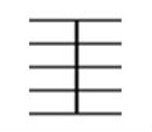
Double Bar Line
It is used to divide fragments of music consisting of several measures or bars. They can be used to indicate the culmination of a melody, or the passage from one musical theme to another, among others.

Repeat Symbol
They indicate that a musical segment, from the repetition start measure, including this one, must be repeated as many times as indicated in the score. It is usually repeated only once.

End Bar Line
It marks the end of a musical work, piece or song.

The bars structure the musical discourse by forming motifs, counter-motives and phrases, and are combined with the harmonic zones of tension and rest, since the bars or meausres also have strong and weak parts. This combination is known as harmonic rhythm.
Free software to write sheet music
We recommend an excellent software for writing scores online, which in its free version is very well performing and which you can access on its official website by clicking on the link. You can write in staff, tablature or encrypted script. His name is Musescore.
This app is ideal to accompany you in your learning.
Conclusion: How to read sheet music for guitar or bass?
Learning to read sheet music usually requires a teacher, but with patience and practice you can take your first steps. It is also important to sing the music that we read and to know how to recognize the intervals, chords and other musical resources that are represented in a score, and this requires a lot of practice and personal guidance.
A teacher will guide us in the intonation of music with the guitar, bass or the piano, which is a very important part of learning to read sheet music, Solfeggio.
Another very important discipline is musical dictation, which consists of knowing how to identify music when listening to it and being able to write or reproduce it with our instrument.
The great reading musicians can read at first sight a score, that is, without having studied it beforehand or with a simple review. They are also capable of transposing written music to any different key, making use of the different clefs. All these skills require a lot of study and experience.
We recommend this review of the best cheap acoustic guitars for intermediate and beginner guitarists.


